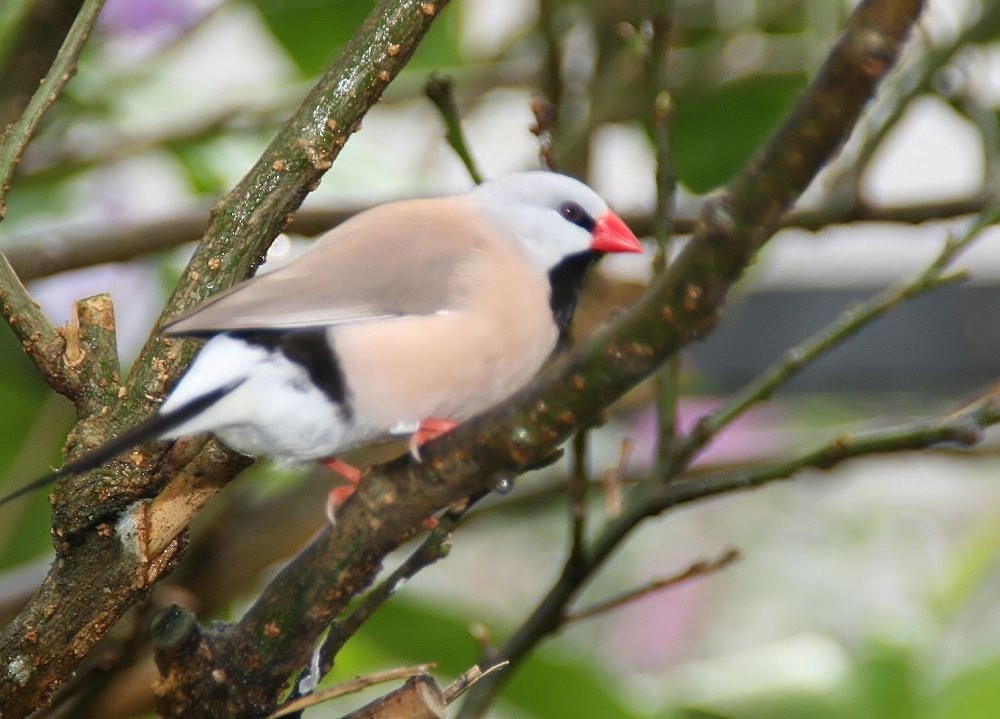Long-tailed Finch
A species of Black-throated Finches Scientific name : Poephila acuticauda Genus : Black-throated Finches
Long-tailed Finch, A species of Black-throated Finches
Botanical name: Poephila acuticauda
Genus: Black-throated Finches
Content
Description General Info
 Photo By Photo by David J. Stang , used under CC-BY-SA-4.0 /Cropped and compressed from original
Photo By Photo by David J. Stang , used under CC-BY-SA-4.0 /Cropped and compressed from original Description
The adult long-tailed finch is around 160 mm in length, the weight range of males is 13.5–16.2 grams and females 11.4–17.6 g. It has a prominent roundish black bib on its throat and upper chest and a long pointed black tail. It has pinkish brown upperparts with paler plumage below its bib over the lower breast and abdomen. It has a grey head, a white ear-patch, and black lores. It has black patches on its upper flanks and its rump and undertail coverts are white. The beak colour of the adult long-tailed finch varies from red through orange to yellow. Males and females are similar, except the females may be slightly duller and may have a slightly smaller bib. Females have shorter wings and tails than males on average, but their measurements, as well as throat bib size, generally lie within the range of male measurements. Furthermore, male and female plumage is indistinguishable in ultraviolet and visible light. A study published in 1999 showed that male long-tailed finches were unable to determine the sex of unfamiliar members of their species unless the latter bird declared its sex by song. Juveniles have black beaks and shorter tail feathers. The subspecies are distinguished by the bill coloration, the nominate western group presenting a yellow colour and the eastern P. acuticauda hecki is red. 
Size
15 cm
Life Expectancy
5-9 years
Nest Placement
Tree
Feeding Habits
Long-tailed Finch primarily feed on ripe and half-ripe grass seeds, like those from Sorghum. They also consume insects, including larvae and adults, showing adaptive foraging behaviors. Their diet showcases a preference for certain grass genera, displaying species-specific dietary tendencies.
Habitat
The long-tailed Finch predominantly inhabits dry grassy savannas interspersed with watercourses, preferring areas where they can find a mix of grassy bushland and Pandanus savannas. This bird species is typically associated with open habitats in tropical and subtropical regions, where these environmental conditions provide suitable nesting sites and feeding opportunities.
Dite type
Granivorous
General Info
Feeding Habits
Bird food type
Behavior
The species maintain a simple pair bond, with some records of extended family groups or in small flocks; the pairs remain in close proximity when engaged in their activities. Individuals use song to identify themselves to a partner, and they maintain contact with a 'distance call' Male P. acuticauda approach unfamiliar members of the species and engage in a courtship display, holding themselves in an upright posture and singing, before attempting to mate with the newcomer. Male newcomers will sometimes not declare their sex when confronted by a group of birds. The authors of the study propose this is a survival mechanism to reduce harassment, increase chances of acceptance into the group and hence chances of future reproduction. The species breeds in natural hollows of trees or lower vegetation like tussocks of grass or shrubs. Where trees are available, the nest site may be over 4 metres from the ground, perhaps as high as 18 m. Eucalpyts are a favoured tree species, and pandanus are also selected. Brreding nests are carefully constructed from grass, the outer layer composed of broader blades 150–200 mm long and the inner chamber with a nesting cup woven from fine stems and seed-heads; woolly plant fibres and sometimes feathers are used to line the inner chamber. The total length of this structure is from 180 to 230 mm and is composed of up to 500 pieces, which includes an entrance is between 50 too 100 mm, in bottle or funnel shaped form. The nest used for roosting outside of the breeding season is a simpler design Pairs share feeding responsibilities, and there has been one report of birds from older broods helping their parents raise the following brood, the first time that cooperative breeding has been recorded in an Australian estrildid finch. The clutch consists of four to six dull white oval eggs measuring 17 x 12 mm. A survey in the Kimberley recorded the clutch sizes as 10 × 4, 10 × 5 and 3 nests × 6 eggs. The incubation period is 13 to 17 days. 
Distribution Area
The long-tailed finch inhabits open woodland across northern Australia, from Derby in the northwest Kimberley region across to the east to the Leichhardt River in northwest Queensland. It has an estimated global extent of occurrence of 1,000,000–10,000,000 km. The IUCN has classified threats to the population of the species as being of least concern. 
Species Status
Not globally threatened.
Scientific Classification
Phylum
Chordates Class
Birds Order
Perching birds Family
Estrildid finches Genus
Black-throated Finches Species
Long-tailed Finch